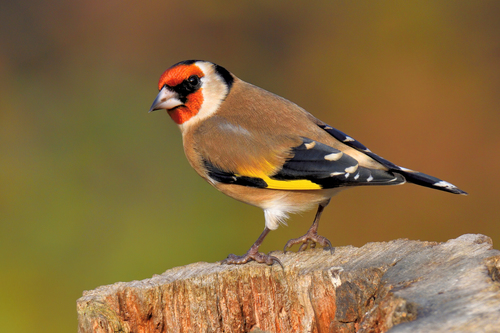
European Goldfinch
The European Goldfinch (*Carduelis carduelis*) is a small, brightly colored songbird known for its vibrant red face, black and white head, and yellow wing bars. It plays a significant ecological role as a seed disperser, contributing to the health and diversity of plant communities. Culturally, the Goldfinch has been a symbol of good luck and perseverance, often featured in Renaissance art and literature, reflecting its cheerful song and striking appearance.
12-13 cm
Length
21-25 cm
Wingspan
Least Concern
Conservation Status
Distribution
Native to Europe, North Africa, and western and central Asia. Introduced populations exist in Australia, New Zealand, and parts of South America. It is largely resident but northern populations may migrate south for winter.
Lifespan
Typically 2-3 years in the wild, but can live up to 10 years in captivity.
European Goldfinch's Habitat
Habitat Types
Open woodlands, Orchards, Parks, Gardens, Hedgerows, Farmland with weeds
Climate Zones
Temperate, Mediterranean
Adaptations
Their fine beaks are perfectly adapted for extracting seeds from thistles and teasels, their preferred food sources.
Variations
Numerous subspecies exist, differing slightly in plumage and size. For example, the British subspecies (*Carduelis carduelis britannica*) is slightly darker than the continental form.
Appearance
Breeding Plumage
Plumage is generally consistent year-round, though it may appear slightly brighter during the breeding season due to fresh feather growth.
Seasonal Feather Changes
Minor wear and tear may make plumage appear slightly duller outside of the breeding season.
Sex Based Plumage Differences
Males generally have a slightly larger and darker red mask that extends behind the eye, while in females, the red does not reach past the eye. However this is not always a reliable way to differentiate between sexes
Notable Features
Bright red face, Black and white head pattern, Bright yellow wing bars, Black wings with white spots
Diet and Feeding
Primary Foods
Seeds (especially thistle and teasel), Small insects (especially during breeding season)
Foraging Behavior
Goldfinches are agile and often feed upside down, clinging to seed heads. They are also known to visit bird feeders, particularly those with niger seeds.
Specializations
Their slender, pointed beaks are specialized for extracting seeds from difficult-to-reach places within flower heads.
Seasonal Diet Variations
The diet is primarily seeds year-round, but insects become a more significant component during the breeding season to provide protein for growing chicks.
Behavior
Social Structure
Highly sociable, often forming small flocks called 'charms,' especially outside of the breeding season. They may also join mixed-species flocks.
Communication
A pleasant, liquid, twittering song, Various calls, including a distinctive 'tswitt-witt-witt'
Migration
Northern populations are partially migratory, moving south for the winter. Southern and western European populations are largely resident.
Territorial or Group Behaviors
Males defend a small territory around the nest during the breeding season. Outside of breeding, they are highly gregarious.
Conservation
Threats
Habitat loss (due to agricultural intensification and urbanization), Pesticide use (reducing insect prey and contaminating seeds), Illegal trapping (in some regions)
Protection Programs
Habitat restoration projects, Agri-environment schemes that promote biodiversity
Local National Laws
Protected under the Wildlife and Countryside Act 1981 in the UK, and similar legislation in other European countries.
Population Trend
Stable
Population Estimates
The global population is estimated to be between 70,000,000 and 199,999,999 individuals.
Interesting Facts
Goldfinches are highly associated with thistles.
Their scientific name, *Carduelis carduelis*, is derived from the Latin word for thistle, *Carduus*.
A group of goldfinches is called a 'charm'.
This collective noun reflects their delightful song and appearance.
They were once popular cage birds.
Due to their attractive plumage and song. This practice is now largely illegal in many countries.
Faqs about European Goldfinch
What do I do if I find a baby goldfinch?
If the bird appears healthy and is fully feathered, it is likely a fledgling that is still being cared for by its parents. It is best to leave it alone. If it is injured or clearly orphaned, contact a local wildlife rehabilitator. *Consult a professional for expert advice.*
How can I attract goldfinches to my garden?
Provide a source of fresh water, plant seed-bearing plants like thistles and teasels, and offer niger seeds in a suitable feeder.
Are goldfinches aggressive?
Goldfinches are not generally aggressive, although males may show some territorial behavior around the nest during the breeding season. They are usually quite tolerant of other birds.
Copyright @ Nature Style Limited. All Rights Reserved.
 English
English